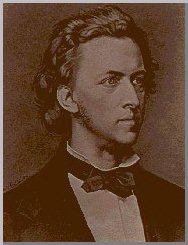
|
|






|







 Frederic Francois Chopin was one of the most
eminent composers of piano music. He was born on Mar. 1, 1810,
in Zelazowa Wola, near Warsaw, Poland. His father was French, and
his mother Polish.
Frederic Francois Chopin was one of the most
eminent composers of piano music. He was born on Mar. 1, 1810,
in Zelazowa Wola, near Warsaw, Poland. His father was French, and
his mother Polish.Chopin gave his first public piano recital at the age of eight and began concert tours in 1828. After visits to several German cities and to Vienna with a return to Warsaw in 1829, he gave a concert in Paris in 1832. He then decided to settle in Paris permanently.
Robert Schumann had acclaimed Chopin's variations on La ci darem la mano (from Mozart's Don Giovanni) with the words "Hats off, gentlemen! A genius!" and later called him "the boldest and proudest poetic spirit of the time." Chopin excelled as a piano teacher, gave yearly concerts of his own music, and frequently performed in the fashionable Parisian salons; he was renowned for his subtle and refined playing.
In 1837, Franz Liszt introduced Chopin to the writer George Sand. She spent the winter of 1838-39 on the island of Majorca with Chopin, who was suffering from a respiratory ailment. Their relationship continued until 1847, and after they separated, Chopin's ailment was diagnosed as tuberculosis. Exhausted by a concert tour of England and Scotland in 1848, Chopin returned to Paris, where he died on Oct. 17, 1849.
Aside from several songs and pieces for cello and piano, Chopin wrote almost exclusively for the piano and its sonorities. His playing included rubato, a flexibility of tempo essential for the proper interpretation of his music.
Chopin's shorter works can be divided into two groups: stylized dances and free lyrical forms. Among the dancelike compositions are the Mazurkas, which are based on Polish dances in 3/4 time. Important among the smaller lyrical forms are Les preludes (1836-39; 1845) and two Books of etudes (1829-32; 1832-36), a genre that Chopin raised from the level of a technical exercise to a work of musical merit.
Among the longer forms, the Polonaises, aristocratic dances that Chopin filled with the spirit of his native Poland, Nocturnes, and Ballades deserve special mention. Chopin's nocturnes range from melodious salon pieces to deeply pessimistic compositions. The ballades consist of aptly juxtaposed sections that make up a musical whole.
Of Chopin's large-scale works, the two piano concertos (F minor
and E minor) are early compositions; his mature piano sonatas
(in B-flat minor, which contains the well-known Funeral March,
and in B minor) show many structural and harmonic ingenuities.
His F Minor Fantasy was one of the works that influenced Liszt's
new concepts of musical form. Chopin's style includes delicate
passage work and subtle melodic ornamentation. His harmonic
innovations influenced Liszt, Wagner, and Scriabin.
![]() Etude op.10, n.12 - MIDI (16K)
Etude op.10, n.12 - MIDI (16K) ![]()
![]() Prelude op.28, n.7 - MIDI (1.5K)
Prelude op.28, n.7 - MIDI (1.5K) ![]()
![]() Valse op.64, n.1 - MIDI (12K)
Valse op.64, n.1 - MIDI (12K) ![]()
![]() Valse op.18, n.1 - MIDI (30K)
Valse op.18, n.1 - MIDI (30K) ![]()
![]() Nocturne op.9, n.2 - MIDI (21K)
Nocturne op.9, n.2 - MIDI (21K) ![]()
Go to the top of the page